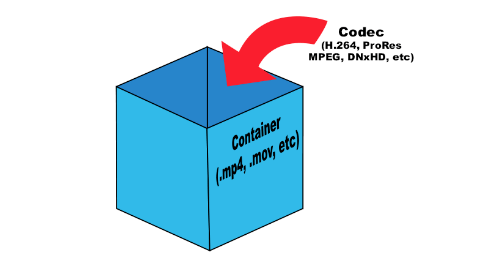
Nowadays, people have cost much time for multimedia to colorize their daily lives. They may use a professional camera to record their daily life. Or they may pay for music or movies online to enjoy on the trip or on the room with their lovers. People also have more choice for different devices these days. Someone like Apple's products, someone may like Samsung mobile and any others. I think it's time for us to learn more useful knowledge about the video or audio contains and codecs. Let's introduce here.
- Part 1. Definition of Video Contain Formats and Codecs
- Part 2. Differences between Video Formats and Codecs
- Part 3. Samples of Popular Video Containers and Codecs
Part 1. Official Definition
First-time users often stumble when trying to figure out the difference between codecs and containers. They may think of video files as "AVI files" or "MP4 files." In reality, "AVI" and "MP4″ are just container formats. Here, let's learn their definitions below.
What's a Video Format Container
A container or wrapper format is a metafile format whose specification describes how different elements of data and metadata coexist in a computer file. Containers support a variety of audio and video compression methods and are not tied to one particular audio or video codec. For example, AVI was the first Windows container format, and Matroska/MKV is a popular open source container. MPEG-4, QuickTime and RealMedia are also A/V containers.
What's a Video Codec
A codec – or coder/decoder – is an encoding tool that processes video and stores it in a stream of bytes. Codecs use algorithms to effectively shrink the size of the audio or video file, and then decompress it when needed. There are dozens of different types of codecs, and each uses a different technology in order to encode and shrink your video file for the intended application.
Part 2. Difference Between Video Containers and Codecs
Codec is a method to encoding data specially or compressed data. They are used with QuinticSoftware to reduce the size of the video file to benefit storage and transmission. Though the word codec has become somewhat generic, the term was originally a shortened form of compressor-decompressor. That's what codecs do: they take digital media data and either compress them (for transport and storage) or decompress them (for viewing or transcoding.)
Once the media data is compressed into suitable formats and reasonable sizes, it needs to be packaged, transported, and presented. That's the purpose of container formats--to be discrete "black boxes" for holding a variety of media formats. Good container formats can handle files compressed with a variety of different codecs.
Part 3. Popular Video Codecs and Containers
There are lots of video container formats and Video Codecs. Some of the most popular include:
Popular Container Formats
Advanced Systems Format (ASF), is a Microsoft-based container format. It includes .asf, .wma, and .wmv. Note that a file with a .wmv extension is probably compressed with Microsoft's WMV (Windows Media Video) codec, but the file itself is an ASF container file.
AVI, or Audio Video Interleaved, is a multimedia container format introduced by Microsoft. AVI files can contain both audio and video data in a file container that allows synchronous audio-with-video playback. AVI supports multiple streaming audio and video, although these features are seldom used. Since AVI was developed for Windows, it lacks some features that newer containers like MPEG or MP4 have. Whatever, it has already become one of the most popular and widely used video formats.
MP4, is another container format developed by the Motion Pictures Expert Group, and is more technically known as MPEG-4 Part 14. Video inside MP4 files are encoded with H.264, while audio is usually encoded with AAC, but other audio standards can also be used.
Flash, Adobe's own container format is Flash, which supports a variety of codecs. More recent Flash video is encoded with H.264 video and AAC audio codecs, but don't expect all Flash sites to use only those codecs, particularly if the video was created and encoded in years past.
Popular Video Codecs
H.264/MPEG-4 AVC, This is the most common codec used in modern camcorders and digital cameras that capture to file-based devices (hard drives, memory cards, and so on).
MJPEG (Motion JPEG), This is an older format used by some digital cameras and older devices to capture video. It was developed by the same group (Joint Picture Experts Group) that developed the JPEG photography compression codec, hence the name.
DV and HDV, DV was developed by a consortium of consumer electronics companies that manufacture and sell camcorders. DV is a tape-based standard and is common on camcorders that use mini-DV tape cartridges. (Some versions of DV are used in professional tape-based gear as well, like DVCPRO and DVCAM.) DV itself is limited to standard definition, so one version, called HDV, was created to allow capture of high-definition video to mini-DV tape cartridges.
